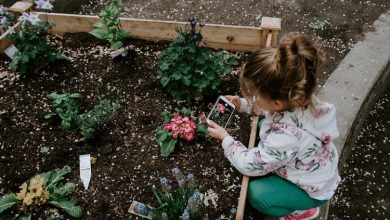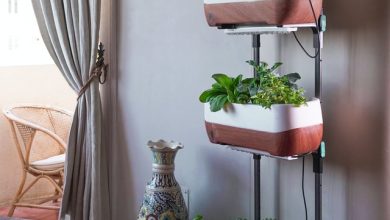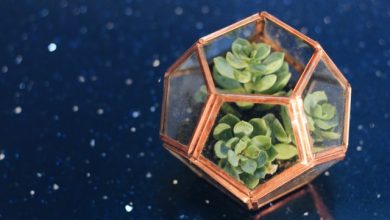8 Plants that Grow in Water Without Hydroponics

Have you ever wanted to grow plants and not mess around with the soil? Growing plants in water is not only easy and mess-free, it’s also just a classy look. Water plants can make for ideal houseplants, and you can even grow herbs you can eat with nothing but a glass of water. To get you started, we’ll go over eight plants that you can grow in water without the use of hydroponics, along with fresh herbs you can easily grow.
What Is Hydroponics?
Hydroponics is a more sophisticated way to grow your plants in water. There are two main forms of hydroponics: top irrigation and sub-irrigation. Hydroponics involves adding nutrients to the water, but what differentiates hydroponics from what we’re going to talk about today is the intricate systems they use to deliver water to the plants.
While you can use hydroponics techniques with something as simple as a mason jar, there is still more involved than casually placing a stem in a glass of water.
The plants we’ll show you below are simple to grow and require no additional equipment or techniques. But first, let’s go over the fresh herbs you can grow in water, as each of these can be grown with the same technique.
How to Grow Fresh Herbs in Water
You can grow the following herbs (and potentially many more) in water:
- Basil
- Chives
- Lavender
- Mint
- Oregano
- Rosemary
- Sage
- Thyme
To grow the herbs, you will first need a healthy plant. Look for a branch with a few leaves growing, and snip it right where the branch meets the main stem of the plant. This area is called the leaf node.
This technique is known as propagation. Most plants can be propagated, but not all plants can be propagated in water.

African Violet
Saintpaulia ionantha
You may recall that we had the African violet under the “expert” category for growing houseplants. And the finicky African violet stays true to its more challenging level of care even when grown in water. But the blooms are worth the fuss.
The first picky aspect of the African violet is that they prefer lukewarm water. If you try growing it in cold water, the propagation is likely to fail.
You also want to make sure not to get any water on the leaves of the plant. If you accidentally water some of the leaves, they may begin to fade in color.
Also, be patient when growing an African violet in water. These plants take their time to grow, but if you wait long enough, you will be rewarded.

Begonia
Begonia cucullata
If you don’t want quite as much of a challenge but still want a beautifully flowering plant, try growing begonias. Some varieties will bloom year long and can be grown in either partial shade or full sun.
The one thing begonias require is warmth. So make sure to keep the plant in a warm part of the room and don’t let the water get too cold.
The best spot for a begonia is on a windowsill that gets plenty of daily sunlight and isn’t too drafty.

Jade Plant
Crassula ovata
Because the jade plant is a succulent, a species that you need to be careful not to overwater, it may seem counterintuitive that a jade plant can grow in water. Many will tell you that this plant will not grow in water, but they simply haven’t tried hard enough.
While sitting in water is not the best long term plan for a jade plant, they will root and grow if you follow some simple instructions.
Cut part of a living jade plant at the leaf node and let the cutting sit undisturbed for up to a week. The idea is to let the stem form a callus, which will help to prevent root rot from the water.
Replace the water frequently to provide fresh nutrients, and try putting a few drops of fertilizer in the water each month.

Lemongrass
Cymbopogon citratus
Growing lemongrass provides you with a variety of different uses, including making teas, cocktails, and delectable Asian dishes. It’s also easy to grow in water.
To begin, make sure you have a stalk of lemongrass with the bulb on the bottom intact.
If the bulb has roots growing from it, that is even better.
Put the stalk in a glass, bulb, and roots at the bottom, and fill the glass with an inch or two of water. Now, just place the glass on a windowsill that gets plenty of sun and watch it grow.
You will want to change the water daily to ensure the plant is getting fresh nutrients.
In two or three weeks, you will notice some serious growth in your plant and can start harvesting.

Philodendron
Philodendron
Philodendron plants might be the easiest of all to grow in water. But you must make sure you begin with a healthy cut. Look about six inches up from the main stem of the plant and find two or three leaves. Cut them off about a quarter-inch below the leaf node. Now, ensure that all the nodes are submerged in water.
That’s it. The roots will now grow on forever in the water.

Peace Lily
Spathiphyllum wallisii
One of the more attractive plants you can successfully grow in water is the peace lily. But you will need to give it a little extra attention.
The peace lily has a dense root system, which can look beautiful when displayed in a glass jar, but requires some initial maintenance.
You will also need to sacrifice a healthy peace lily growing in soil in order to start the process again inside. Start by removing the peace lily and gently rinsing the roots with lukewarm water to remove all the soil. Cut off the crown of the lily and trim any offshoots growing from the roots. Make sure to keep three or four leaves intact.
Now the peace lily is ready to be replanted in a jar of water. You should change the water weekly, and adding a drop of fertilizer at this time will only help.

Spider Plant
Chlorophytum comosum
We went over the spider plant in our look at the 11 best small houseplants. It’s also a plant that is completely safe for cats and dogs if they happened to take a bite.
Spider plants are not the best at growing in water, but they will grow. So if you already have a healthy spider plant, you can have some fun trying to grow it in water. At full maturity, spider plants grow dozens of new leaves that spiral and curl out of the base, which means that it should not be difficult to find a section to snip.
Remove a small clump of leaves from the base of the plant and place it in a jar of water. Once you see roots beginning to form, add pebbles to the water. The roots should cling to the pebbles, and you will only need to make sure that the roots are sitting in water.
You will want to change your water weekly. And if you have some extra fertilizer, you can add a bit to the water when you change it.

Water Lily
Nymphaea
Apart from their striking good looks, the best part about water lilies is that they will only grow in water!
If you happen to have a pond or an aquarium, a water lily is an ideal addition.
To grow water lilies to their fullest form indoors, you will need a large container that can hold around 20 gallons of water. But if you have a container that can hold around five gallons, that will work too. Your plant will simply grow as far as the container will allow.
If you have a pond or a large enough container, a single water lily can grow to 12 square feet, with flowers as large as 12 inches wide.
A great place to put your collection of water lilies is in a large tub on your porch.
There are two distinct varieties of water lilies: tropical and hardy. Hardy water lilies were bred to withstand cold temperatures, while tropical water lilies can be more colorful but need warmer conditions.
The water temperature should be at least 70 degrees Fahrenheit for tropical water lilies to thrive. Direct sunlight outdoors during the summertime gives this plant its best growing condition. If you live in an environment that is warm year-round, you will be in the best position to grow and maintain this gorgeous plant.
But if you live in an area where the temperature drops in the fall and winter, you will have to move your plant indoors or simply get the hardy version.
Fear not if you don’t have a large container or an outdoor pond. You can grow water lilies and display them even more splendidly in smaller glass containers. The variety of water lily you will be looking for is a dwarf lily.
Get a flower arrangement holder, place it at the bottom of the glass, and press the stems of the lilies into the holder. Now, cover the holder up with some small stones to hide it. Fill the glass with water so that the leaves are just barely submerged, but make sure the flower is not. Place the glass near a window that gets plenty of sunlight, and you should have success.



